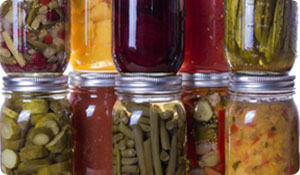
Canning, which means preserving food in metal cans or glass jars, can be a great way to save money and maintain foods' nutrients for far longer than would normally be possible. Imagine savoring the sweetness of a peach in the dead of winter, or having homemade jam to spread on your toast every morning. But the process has a bit of a learning curve, and done incorrectly can lead to dangerous bacteria growth. It's important to follow manufacturers' directions when buying a canning set. You might also consider taking a canning class or downloading specific instructions on the computer. Here's a quick overview of the process:
Basic Tools
If you're canning high-acid foods such as tomatoes and other fruits, you'll need a water bath canner. Canning low-acid foods such as vegetables, meats, and seafood requires a pressure canner. In all cases, you'll need a supply of mason jars (with lids and screw tops), a jar lifter to remove hot jars from the canner, a funnel to make packing the jars easier, a plastic knife or spatula to remove bubbles from the jars, and clean cloths and towels.
First Step
After thoroughly washing jars, sterilize them by submerging them in water and bringing them to a boil for at least 10 minutes. Cooks at higher altitudes will need to add boiling time.
Filling Jars
Foods that are particularly acidic should be hot packed, which means they're brought to a boil and simmered for a few minutes before being put into jars. Vegetables can usually be raw packed, which means they're put into jars uncooked. Be sure to remove air bubbles from the jar while leaving a little space on top for expansion.
Processing
Depending on how a food is packed and how large the jars are, a water bath canner may require anywhere from 25 to 60 minutes to process the food while a pressure canner may take from 55 to 100 minutes.
Cooling
Jars are removed from the canners and left to cool at room temperature for up to 24 hours. You can test the seals at this point by pressing down on them. If they don't pop back up, they're properly sealed, and can be stored for up to a year.
Sources:
University of Minnesota Extension. "Canning Basics 5: Equipment Used for Home Canning." Web. http://www1.extension.umn.edu/food-safety/preserving/canning/
United States Department of Agriculture. "Principles of Home Canning." Web. http://nchfp.uga.edu/publications/usda/2_USDAcanningGuide1_06.pdf





